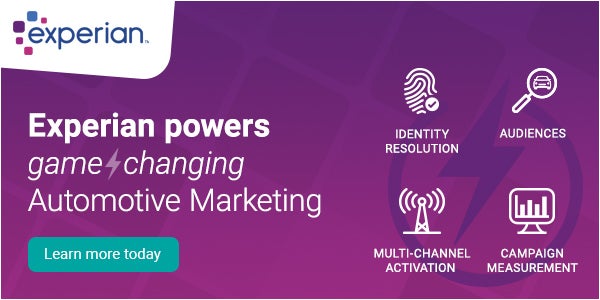This article is sponsored by Experian.
Identifying the right prospects has always been an important first step for any successful marketing campaign, but in the current COVID-19 landscape – and the new normal that will soon follow – it’s crucial to connect with the right audience. The pandemic has created a fluid situation for people, and it’s impacted everyone differently. Marketers need to understand the struggles people are facing and lead with empathy.
But the challenge was the same even before COVID-19. With the proliferation of devices, marketers are facing data fragmentation, siloed data platforms, data freshness and the move toward a cookieless environment – all of which threaten a marketer’s ability to resolve customer identities across devices and platforms, resulting in disjointed campaigns.
For instance, the average household now uses 11 different connected devices, according to a 2019 Deloitte survey. This device proliferation creates disconnected data streams that can wreak havoc on audience-building strategies. As a result, less than 25% of marketers feel comfortable in their ability to manage customer IDs across devices.
In many of the most data-driven consumer markets – such as the auto industry – a lack of proper audience identification can be a costly mistake that wastes valuable budget on consumers who have no intention of leasing or purchasing a vehicle. But more than that, communication to an out-of-market consumer may be perceived as insensitive and potentially ruin a long-term relationship down the road – particularly in the current environment.
“[Original equipment manufacturer] marketers have long used key performance indicators that are web-based,” said Laurel Malhotra, director of OEM marketing at Experian. “So, if you think about the proliferation of mobile and less reliance on cookie-based identifiers, it presents a challenge that marketers are trying to get their arms around – how they can consolidate all these data streams to understand which audiences are most receptive and what messages perform best.”
Building high performing audiences – for automotive marketing or any other industry – starts with leveraging advanced analytics, such as machine learning, to bring these disparate data sets together to create a single customer view, empowering marketers to uncover actionable insights that will help move the needle at each touchpoint in the customer journey.
Strong consumer outreach starts with data
Experian has been surveying the general population to better understand shifting consumer sentiment as a result of the pandemic. Using the automotive example, as of May 11, 19% of respondents were considering buying a new vehicle in the next few months, however the percentage varied greatly by age demographic. Twenty-eight percent of Generation Z (aged 18-25) and 27% of millennials (Gen Y, aged 26-40) shared the same sentiment. Drilling further into the survey, some respondents planned to move forward with a purchase as planned, while others considered a less expensive option.
The survey shows that, even in the current market, some consumers are exploring buying their next vehicle. There are certain indicators that can help manufacturers and dealers identify in-market car shoppers: car-buying history, as well as consumer demographic and psychographic traits. Marketers need to understand their audiences, as well as the challenges they’re facing. It’s about providing the right resources to help customers as quickly as possible. When even one of these sources of data is missing, marketers run the risk of executing less effective campaigns – or worse, reaching out-of-market segments altogether.
Take the millennial auto buyer, for example.
Prior to the pandemic, some demographic trend reports suggested millennials are skipping cars in favor of greener transportation options. But this assumption is based on an incomplete view of the millennial consumer—according to the Experian survey, millennials are among those most considering purchasing a new vehicle in the next few months. In order to get the full picture, marketers need to leverage data to create a more nuanced look at the motivations and buyer actions within this segment.
By layering in demographic and psychographic data on top of expansive automotive data, a recent Experian study reveals that millennials actually offer a strong segment to connect with automotive messages and offers. In fact, the study shows millennials will soon surpass baby boomers (aged 56-80) for the largest share of car registrations in the United States.
“From there, the key then is uncovering the insights that reveal how a consumer segment thinks about car buying,” Malhotra said. “When marketers work with data that overlays car purchases with consumer demographic and psychographic profiles, it provides a more holistic view than any of these data sets alone – which can inform the right marketing mix and message offers to facilitate the customer journey.”
Partnering with data providers such as Experian can help marketers gain insight into in-market consumers and better understand preferences and behaviors, which is critical to produce accurate, powerful, predictive models that will inform effective campaigns. Using Experian In-Market Auto Audiences to target likely purchasers increases the new vehicle buy rate as much as four times.
Customer priorities are constantly in flux right now, so focusing on the audience will ensure that marketers are connecting with consumers who are looking for their resources.
“Finding the right audiences in the modern media environment doesn’t have to be complex,” Malhotra said. “When OEMs have access to the right mix of data sources, and powerful tools to analyze and filter that audience data, it becomes much easier to map a consumer identity that illuminates insights and strategies within the marketing ecosystem.”
















